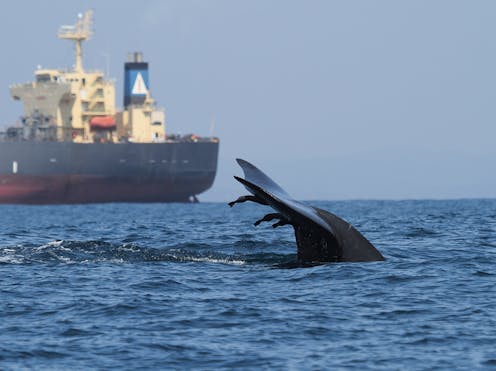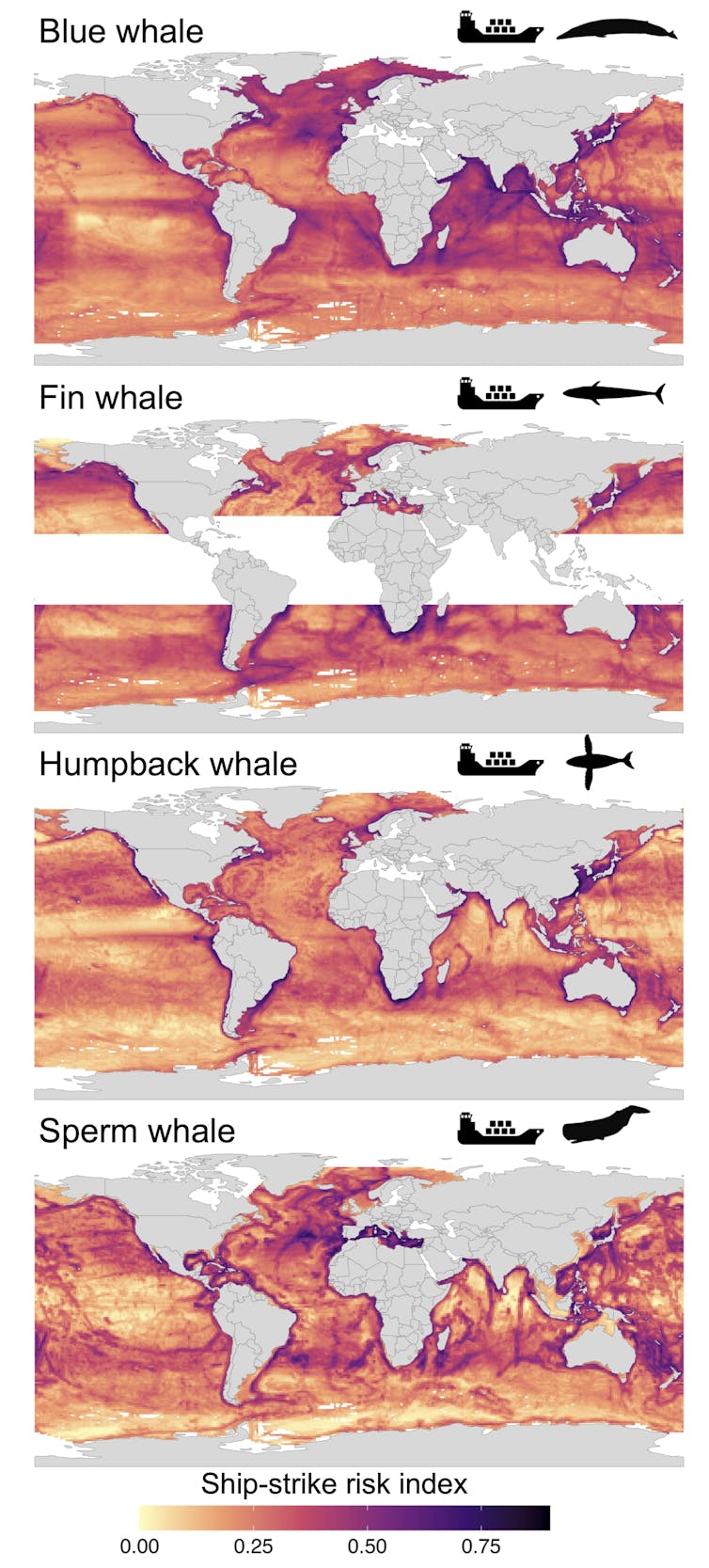New maps show high-risk zones for whale-ship collisions − vessel speed limits and rerouting can reduce the toll
- Written by Anna Nisi, Postdoctoral Researcher in Biology, University of Washington
 A blue whale swims close to a large vessel near the Port of Colombo, Sri Lanka.
Asha de Vos, CC BY-ND
A blue whale swims close to a large vessel near the Port of Colombo, Sri Lanka.
Asha de Vos, CC BY-NDImagine you are a blue whale swimming up the California coast, as you do every spring. You are searching for krill in the Santa Barbara Channel, a zone that teems with fish, kelp forests, seagrass beds and other undersea life, but also vibrates with noise from ship traffic. Suddenly, the noise gets louder.
You start to make a slow, shallow dive, but without much urgency – after all, your species evolved over millions of years without this mysterious noise, so why would you know what to do when you hear it? A minute later, you are fatally struck by a container ship.
Your body slowly sinks to the bottom of the ocean, where it will nourish deep-sea creatures for decades but will never be seen by humans again. Indeed, your death goes unnoticed; the vessel barely registers the impact of hitting a member of the largest animal species on Earth.
Collisions with ships are a critical threat to many large whale species. While these events are difficult to study, scientists estimate that thousands of whales are killed by ships yearly. In some regions, whales die from vessel strikes at rates that exceed what is considered sustainable after decades of whaling. Collisions with vessels threaten some critically endangered species.
Research and experience show that simple measures can reduce these collisions – for example, rerouting shipping lanes to avoid important areas for whales, or reducing vessel speeds. But to implement these interventions, scientists and policymakers need to know where whales are most at risk.
Colliding with cruise and container ships is one of the most serious threats to endangered whale species.Mapping risk to whales
In a newly published study in Science, colleagues and I mapped global ship-strike risk for four species of Earth’s largest whales: blue, fin, humpback and sperm. Within each species’ range, we found that vessels traveled the equivalent of thousands of times the distance to the moon and back every year.
Our maps reveal widespread risk of vessel collisions in areas including the U.S. West Coast, the Mediterranean Sea and the northern Indian Ocean. These zones already have documented high levels of ship strikes.
We also found many other regions with similar levels of risk that are less studied and recognized. They include several stretches along the coastlines of South America and southern Africa, and the area around the Azores off the coast of Portugal.
 Predicted patterns of whale-ship collisions for blue, fin, humpback and sperm whales. Areas in purple are places of higher ship-strike risk, with high levels of shipping traffic and high habitat suitability for each species. Ship-strike risk was predicted for each species across their range map – as defined by the International Union for Conservation of Nature – which for fin whales excludes the tropics.Anna Nisi, CC BY-ND
Predicted patterns of whale-ship collisions for blue, fin, humpback and sperm whales. Areas in purple are places of higher ship-strike risk, with high levels of shipping traffic and high habitat suitability for each species. Ship-strike risk was predicted for each species across their range map – as defined by the International Union for Conservation of Nature – which for fin whales excludes the tropics.Anna Nisi, CC BY-NDMost high-risk areas are unprotected
Whales are largely unprotected from vessel collisions around the world. We identified collision-risk hot spots – areas in the top 1% of predicted risk globally that represent the riskiest places for each species.
We found that fewer than 7% of collision-risk hot spots had put measures in place to reduce collisions, such as limiting vessel speeds or requiring ships to avoid certain areas. Exceptions include the west and east coasts of North America, as well as the Mediterranean, which have higher levels of ship-strike management.
Where such measures exist, they often are voluntary. Mandatory restrictions on speed cover just 0.54% of collision-risk hot spots for blue whales, 0.27% for humpback whales and none of the hot spots for fin or sperm whales.
For each species, we found that ship-strike risk was higher within exclusive economic zones – areas up to 200 nautical miles from coastlines, in which each country has exclusive jurisdiction over marine resources – than on the high seas. This can make it easier to implement conservation and management measures in these areas.
Within exclusive economic zones, individual countries can either adopt voluntary vessel measures or propose mandatory changes through the International Maritime Organization, which regulates international shipping. There is a lot of opportunity for countries to protect whales in their national waters.
However, since political boundaries mean nothing to whales, the most effective approach would be for neighboring countries to coordinate efforts to reduce ship-strike risk across whale migratory routes.
This video shows whales’ use of space in the ocean, shaded from blue (lower use areas) to white (high use areas), with global ship traffic overlaid on it, colored by vessel speed.We also found high levels of ship-strike risk within existing marine protected areas – zones where countries have adopted various measures to conserve and manage sea life. Most of these marine protected areas were created to protect sea life from fishing, but very few place any restrictions or regulations on shipping. When marine protected areas contain high levels of ship-strike risk, governments could add such measures to the protected areas’ missions.
Benefits of protecting whales
Protecting whales from ships would benefit other species too. Vessels can strike many marine species, including seals, sea turtles, sharks, fish, penguins and dolphins.
Marine shipping is the top source of underwater noise, which is a major threat to marine life. Underwater noise can disrupt feeding, interfere with communication and cause stress for many species. Vessels run more quietly at slower speeds, so speed-reduction measures can reduce noise pollution as well as collision risk.
Underwater noise from a large cargo ship, recorded off Perth, Western Australia.Humans can also benefit from slowing down and rerouting ships. When vessels travel more slowly, their fuel efficiency increases, reducing their greenhouse gas emissions. The marine shipping industry currently produces carbon emissions comparable to those from aviation.
Slowing vessels down also reduces emissions of harmful air pollutants that threaten human health in coastal areas and are estimated to contribute to hundreds of thousands of premature deaths annually. In 2023, for example, vessels cooperating with a voluntary slowdown in California cut 45,000 metric tons of greenhouse gas emissions and 1,250 metric tons of nitrogen oxides, and they reduced the risk to whales by more than half.
Changing vessel routes can make waters safer for local fishermen. In Sri Lanka, for example, heavy ship traffic hugs the coast, overlapping with local fishermen as well as with foraging blue whales. Collisions with cargo ships have killed several fishermen there in recent years. In response, some shipping companies are voluntarily shifting their lanes farther offshore to reduce the risk of colliding with humans and whales.
In our interconnected world, 90% of consumer goods travel by ship before they get to market. Most items that consumers in wealthy nations purchase in their daily lives have traveled across the ocean at some point.
Our study shows that ship-strike risk is widespread – but in our view, protecting whales from these collisions is a solvable issue. And by protecting whales, humans can also protect themselves.
This article has been updated to add a video showing areas of the ocean that are used by whales, mapped in combination with global ship traffic.
Anna Nisi receives funding from The Nature Conservancy.
Authors: Anna Nisi, Postdoctoral Researcher in Biology, University of Washington

